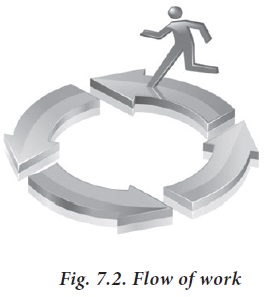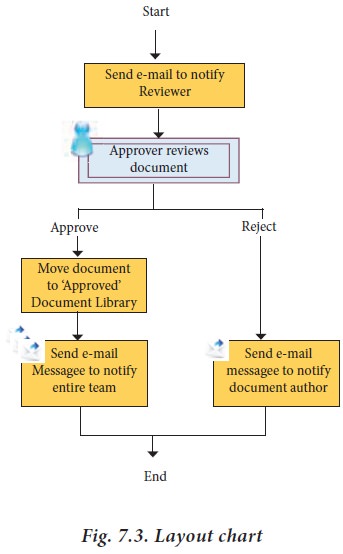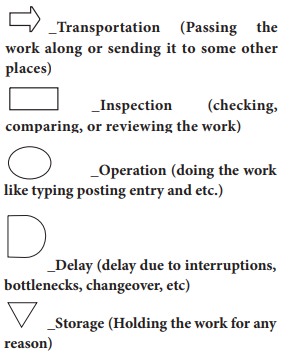Office Systems and Procedures - Flow of Work | 11th Office Management and Secretaryship : Chapter 7 : Office Systems and Procedures
Chapter: 11th Office Management and Secretaryship : Chapter 7 : Office Systems and Procedures
Flow of Work
Flow
of Work:

Flow
of work is concerned with the way work move along with one operation to
another. It denotes the volume of work going through the rate at which it moves
along and the smoothness of its passage.
The
flow of work aims at greater efficiency in every office activity, so that costs
are cut down and delays are eliminated. Flow of work is a problem to be solved
by the managers.
Flow
charts are prepared for the purpose to know whether the flow of work is ideal
or there is scope for improvement. The following types of flow charts can be
used for analysis.
a. Office Layout Chart.
This
chart analyses the flow of work of each part of office and eliminates waste
motion & back tracking. In the chart, lines are drawn to indicate the
movement of office forms and documents from operation to operation.

b. Flow Process Chart:
Process
chart is also known as work simplification chart. By using certain standard
symbols, the chart shows the flow of work under a specific procedure.
Presentation and reading is easy because the charts are more graphic with
symbols.
It
helps to simplify the work. These standard symbols have been developed by the
American society of mechanical engineer, New York.

c. Management Type Flow Chart:
Management
type flow chart is fully illustrated chart and each operation or steps involved
are described in short and descriptive sentence. The chart is written and read
horizontally from left to right.
Straight-Line Flow of Work:
Smooth
flow of work can be ensured by the use of straight-line flow of work method.
This method is applicable for the factory as well as the office. It can be
described as the method, in which the work flows, while progressing from one
operation to another, it should follow a course approximating as nearly as may
be possible in a straight line. In order to avoid the wastage of time, effort
and delay in the flow of information, the work must always move forward and in
a straight-line.
Benefits of Straight-Line Flow of Work:
The
following are the list of benefits of Straight-line flow of work:
1. Greater Speed: The speed of work increases greatly, since the movement
of work is over the least area.
2. Lesser Messenger Work: Since the work is flowing in a straight-line, the desks can be arranged in a
straight-line, the distance between the different operations is small and the
papers or files are passed over from one desk to another by the clerks is easy.
It reduces the messenger work.
3. Less Loss of Papers: In this method, papers are rarely mislaid or lost as they are handled in a
systematic manner.
4. Use of Conveyors: In certain organization conveyors are used to transfer the
files from one place to another, such an arrangement helps to speed up the
work.
5. Keeps Executives and Clerks at
Their Desks: As
the work moves in a straight-line, this
method avoids moving here and there unnecessarily and makes the employees to
sit in their chair to do the work.
Problems in Smooth Flow of Work:
Smooth
flow of work faces number of problems, which must be tackled in order to
improve the efficiency of office routine. It can be solved only by the
managers. The problems are outlined below:
1. Unequal Flow of Work: The work in the office cannot be equal throughout the day, the week or the
year. The work may be heavy on particular day in a week or it may be heavy
during a particular period. For example, there may be greater incoming mails in
the morning and on Mondays. The problem of unusual flow of work can be solved
by collecting relevant statistics and their analysis.
2. Interruptions to Work: The interruptions to work are internal or external.
Internal interruption may be caused by lack of materials with which to work,
information needed is not available or because of change of work through change
of plan, etc. External interruptions to work may be caused by outsiders calling
the employees and external telephone calls.
3. Unequal Times Needed for
Different Operations: This
is the major problem in the flow of
work where, different operations of a job need different time to complete. For
example, the sequence of operations for the first operation may require one
minute, while the next may require three minutes.
4. Lack of Standard: Steady flow of work may also be affected, if the work to
be done by an individual that can not equal to the standard fixed. In the
absence of standard, some employees may over burden with heavy work while the
others may have less work.
5. Lack of Planning and Scheduling: If the office manager does not plan and schedule the work before time, it
is not possible to do the work quickly or not to do the work within the
allotted time.
6. Faulty Layout: Steady flow of work may be affected if the layout of the
office is not made according to a well-developed plan. Criss-crossing and back
tracking procedure will affect the flow of work.
Related Topics